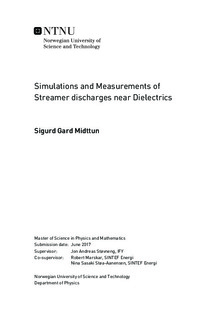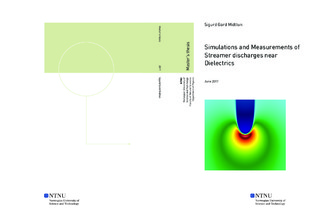| dc.description.abstract | A novel numerical fluid model for simulating streamer discharges has been tested and utilized with a two-diemnsional triple junction configuration. The triple junction was located at the upper end of a 1 cm dielectric rod, and positive streamers were initiated by applying a constant voltage of 18.5 kV to the triple junction anode. After inception, propagation along the dielectric rod was investigated, and the streamer velocities was estimated to be about 0.05 mm/ns. The streamers was found to be very thin, only spanning across three layers of cells, if the charge density was used as a measurement. This was unexpected, and as far as the author is concerned, such a result has not been reported elsewhere. In the layer of cells closest to the dielectric, a very high charge density with a maximal value of 158.3 micro C/cm$ was seen. Simulations have also been performed using a 0.5 mm rod-plane gap configuration with a grounded dielectric barrier, displaying similar results for streamers propagating along the dielectric surface. With this configuration, multiple simulations were performed in order to probe how various electron yield coefficients for photoemission from the dielectric rod affected the dynamics of the streamers. With a coefficient value of 10, the discharge behaved quantitatively different than what was observed when a value of 0.1 and 1 was used. All simulations were performed in a nitrogen-oxygen mixture under normal conditions.
Due to use of an explicit second order Runge-kutta method for advancing the hydrodynamic equations in time, restrictions on the sizes of the time steps had to be followed to avoid instability. Because of stiffness in the equation set, time steps of the order of 1e-13-1e-15 was found to be required for stability. Another issue with the numerical code was uncovered in form of memory leakage, causing the simulations to crash after approximately 13 000 time-iterations. With these limitations, full simulations of streamer propagation along the entire lengths of the dielectric surfaces could not be done.
Also experimental work has been performed with a triple junction configuration similar to that used in the simulations. By means of a high-speed camera with a minimal exposure time of 10 ns, streamer discharges along the dielectric rod was attempted arrested. Based on the experimental data, a lower propagation speed of 1 mm/ns is estimated. It must however be noted that excess charge present on the rod from earlier experiments could have influenced the estimated lower bound propagation speed. | |

